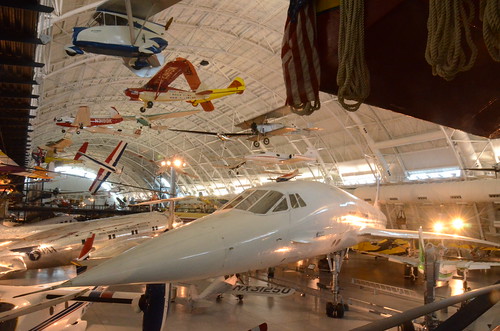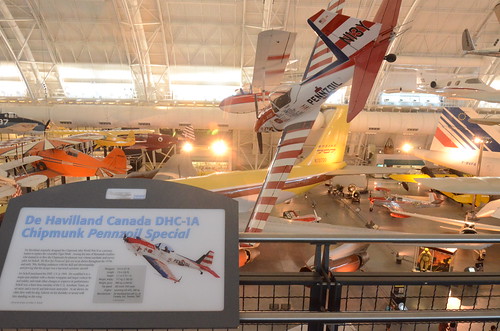Volunteer Service Day
Image by Marymount University
(l-to-rt) Carly Blancato ’16, a Business Administration major; Olivia Fedor ’13, a Criminal Justice, Forensic Science major; and Sami Webster ’16, a Fashion Design major plant a garden at Hoffman-Boston Elementary School in Arlington.
Photo by: Matt Dunham
Download high-resolution photo
Steven F. Udvar-Hazy Center: Air France Concorde
Image by Chris Devers
Quoting Smithsonian National Air and Space Museum | Concorde, Fox Alpha, Air France:
The first supersonic airliner to enter service, the Concorde flew thousands of passengers across the Atlantic at twice the speed of sound for over 25 years. Designed and built by Aérospatiale of France and the British Aviation Corporation, the graceful Concorde was a stunning technological achievement that could not overcome serious economic problems.
In 1976 Air France and British Airways jointly inaugurated Concorde service to destinations around the globe. Carrying up to 100 passengers in great comfort, the Concorde catered to first class passengers for whom speed was critical. It could cross the Atlantic in fewer than four hours - half the time of a conventional jet airliner. However its high operating costs resulted in very high fares that limited the number of passengers who could afford to fly it. These problems and a shrinking market eventually forced the reduction of service until all Concordes were retired in 2003.
In 1989, Air France signed a letter of agreement to donate a Concorde to the National Air and Space Museum upon the aircraft's retirement. On June 12, 2003, Air France honored that agreement, donating Concorde F-BVFA to the Museum upon the completion of its last flight. This aircraft was the first Air France Concorde to open service to Rio de Janeiro, Washington, D.C., and New York and had flown 17,824 hours.
Gift of Air France.
Manufacturer:
Societe Nationale Industrielle Aerospatiale
British Aircraft Corporation
Dimensions:
Wingspan: 25.56 m (83 ft 10 in)
Length: 61.66 m (202 ft 3 in)
Height: 11.3 m (37 ft 1 in)
Weight, empty: 79,265 kg (174,750 lb)
Weight, gross: 181,435 kg (400,000 lb)
Top speed: 2,179 km/h (1350 mph)
Engine: Four Rolls-Royce/SNECMA Olympus 593 Mk 602, 17,259 kg (38,050 lb) thrust each
Manufacturer: Société Nationale Industrielle Aérospatiale, Paris, France, and British Aircraft Corporation, London, United Kingdom
Physical Description:
Aircaft Serial Number: 205. Including four (4) engines, bearing respectively the serial number: CBE066, CBE062, CBE086 and CBE085.
Also included, aircraft plaque: "AIR FRANCE Lorsque viendra le jour d'exposer Concorde dans un musee, la Smithsonian Institution a dores et deja choisi, pour le Musee de l'Air et de l'Espace de Washington, un appariel portant le couleurs d'Air France."
Steven F. Udvar-Hazy Center: De Havilland Canada DHC-1A Chipmunk Pennzoil Special
Image by Chris Devers
See more photos of this, and the Wikipedia article.
Details, quoting from Smithsonian National Air and Space Museum | De Havilland-Canada DHC-1A Chipmunk, Pennzoil Special
De Havilland originally designed the Chipmunk after World War II as a primary trainer to replace the venerable Tiger Moth. Among the tens of thousands of pilots who trained in or flew the Chipmunk for pleasure was veteran aerobatic and movie pilot Art Scholl. He flew his Pennzoil Special at air shows throughout the 1970s and early '80s, thrilling audiences with his skill and showmanship and proving that the design was a top-notch aerobatic aircraft.
Art Scholl purchased the DHC-1A in 1968. He modified it to a single-seat airplane with a shorter wingspan and larger vertical fin and rudder, and made other changes to improve its performance. Scholl was a three-time member of the U.S. Aerobatic Team, an air racer, and a movie and television stunt pilot. At air shows, he often flew with his dog Aileron on his shoulder or taxied with him standing on the wing.
Gift of the Estate of Arthur E. Scholl
Manufacturer:
De Havilland Canada Ltd.
Pilot:
Art Scholl
Date:
1946
Country of Origin:
United States of America
Dimensions:
Wingspan: 9.4 m (31 ft)
Length: 7.9 m (26 ft)
Height: 2.1 m (7 ft 1 in)
Weight, empty: 717 kg (1,583 lb)
Weight, gross: 906 kg (2,000 lb)
Top speed: 265 km/h (165 mph)
Engine: Lycoming GO-435, 260 hp
Materials:
Overall: Aluminum Monocoque
Physical Description:
Single-engine monoplane. Lycoming GO-435, 260 hp engine.
Long Description:
The de Havilland Chipmunk was originally designed as a post World War II primary trainer, a replacement for the venerable de Havilland Tiger Moth training biplane used by the air forces of the British Commonwealth throughout World War II. Among the tens of thousands of pilots who trained in or flew the Chipmunk for pleasure was veteran aerobatic and movie pilot Art Scholl. He flew his Pennzoil Special at airshows around the country throughout the 1970s and early 1980s, thrilling audiences with skill and showmanship, and proving that the design itself was a top-notch aerobatic aircraft.
The Chipmunk was designed, initially built and flown by de Havilland Canada subsidiary, hence the very Canadian "woods country" sounding name of Chipmunk that complemented their other aircraft the Beaver, Otter, and Caribou. The prototype first flew on May 22, 1946 in Toronto. DeHavilland of Canada produced 158 Chipmunks and de Havilland in England produced 740 airplanes for training at various Royal Air Force and University Air Squadrons during the late 1940s and into the 1950s. In 1952, His Royal Highness the Duke of Edinburgh took his initial flight training in a Chipmunk. It was also used in other roles, such as light communications flights in Germany and for internal security duties on the island of Cyprus.
The Chipmunk was an all-metal, low wing, tandem two-place, single engine airplane with a conventional tail wheel landing gear. It had fabric-covered control surfaces and a clear plastic canopy covering the pilot and passenger/student positions. The production versions of the airplane were powered by a 145 hp in-line de Havilland Gipsy Major "8" engine.
Art Scholl purchased two Canadian-built Chipmunks from the surplus market after they became available in the late 1950s and early 1960s. He purchased the two-place DHC-1A, N114V, first and it now resides in the Experimental Aircraft Association's museum in Oshkosh, Wisconsin. In 1968, Scholl bought another DHC-1A and began extensive modifications that resulted in almost a completely new aircraft. He covered over one cockpit to reconfigure the aircraft into a single-place aircraft and installed a (fuel injected) 260 hp Lycoming GO-435 flat-opposed 6-cylinder engine. He removed 20 inches from each wingtip and changed the airfoil section of the tip area. The reduction in span led to the need to lengthen the ailerons inboard to retain control effectiveness. This in turn reduced the flaps to where they became somewhat ineffective, and, since the flaps really were not required for the normal show and aerobatic routines, he removed them as a weight saving measure. These modifications improved the low speed tip stall characteristics and improved roll performance during aerobatic maneuvers.
The vertical fin and rudder acquired a 25% increase in area and an increased rudder throw to manage the effects of increased engine torque and for better directional control during slow-speed aerobatic routines. The standard fixed landing gear was replaced with a retractable gear from a Bellanca airplane. The landing gear was subsequently damaged during a belly landing and resulted in a permanent wheel toe-in that was never repaired. This caused a tire drag during takeoffs and landings that led to the need for tire replacement after about 10 takeoffs and landings. Other idiosyncrasies were the pitot static tube being fashioned from a golf club shaft and a 3-inch extension added to the cockpit control stick to ease the control loads during the more severe aerobatic routines. Scholl also installed rear-view mirrors on both sides of the cowling just forward of the windscreen. He placed an RAF placard on the instrument panel as a memorial to some Vulcan bomber crew members who were his personal friends. He installed three smoke generators with red, white, and blue smoke for his show routines that included the Lomcevak tumbling/tailslide maneuver.
Scholl designed most of these modifications himself, drawing upon his Ph.D. and his 18 years as a university professor in aeronautics. He held all pilot ratings, and was a licensed aircraft and powerplant (A&P) mechanic and an authorized FAA Inspector. He was also a three-time member of the U.S. Aerobatic Team, an air racer (placing several times at the National Air Races at Reno), an airshow pilot, and a fixed base operator with a school of international aerobatics. In 1959, Scholl began working for legendary Hollywood pilots Frank Tallman and Paul Mantz at Tallmantz Aviation and then later formed his own movie production company, producing and performing aerial photography and stunts for many movies and television shows. At airshows, Scholl often flew with his dog Aileron, who rode the wing as Scholl taxied on the runway or sat on his shoulder in the aircraft.
Art Scholl was killed in 1985 while filming in a Pitts Special for the movie Top Gun. Art Scholl's estate donated the Pennzoil Special, N13Y, serial number 23, and his staff delivered it to the Garber Facility in Suitland, Maryland on August 18, 1987. It is currently on display at the Museum's Stephen F. Udvar-Hazy Center at Washington Dulles International Airport in Chantilly, Virginia.
No comments:
Post a Comment